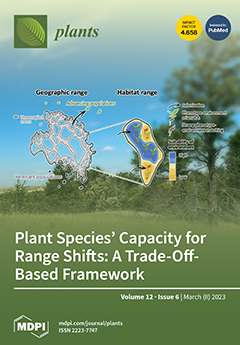Hirsutella citriformis Speare is the only entomopathogenic fungus involved in
Diaphorina citri Kuwayama natural epizootics. The aim of the present study was to evaluate different protein sources as supplements to stimulate
Hirsutella citriformis growth, improve conidiation on solid culture, and evaluate its produced
[...] Read more.
Hirsutella citriformis Speare is the only entomopathogenic fungus involved in
Diaphorina citri Kuwayama natural epizootics. The aim of the present study was to evaluate different protein sources as supplements to stimulate
Hirsutella citriformis growth, improve conidiation on solid culture, and evaluate its produced gum for conidia formulation against
D. citri adults.
Hirsutella citriformis INIFAP-Hir-2 strain was grown on agar media enriched with wheat bran, wheat germ, soy, amaranth, quinoa, and pumpkin seed, in addition to oat with wheat bran and/or amaranth. The results demonstrated that 2% wheat bran significantly (
p < 0.05) promoted mycelium growth. However, 4% and 5% wheat bran achieved the highest conidiation (3.65 × 10
7 conidia/mL and 3.68 × 10
7 conidia/mL, respectively). Higher conidiation (
p < 0.05) was observed on oat grains supplemented with wheat bran, as compared with culturing on oat grains without supplements (7.25 × 10
7 versus 5.22 × 10
7 conidia/g), after a 14 d instead of 21 d incubation period. After supplementing synthetic medium or oat grains with wheat bran and/or amaranth, INIFAP-Hir-2 conidiation increased, whereas production time was reduced. After using
Acacia and
Hirsutella gums to formulate conidia produced on wheat bran and amaranth at 4%, field trial results showed that the highest (
p < 0.05)
D. citri mortality was achieved by
Hirsutella gum-formulated conidia (80.0%), followed by the
Hirsutella gum control (57.8%). Furthermore,
Acacia gum-formulated conidia caused 37.8%, whereas
Acacia gum and negative controls induced 9% mortality. In conclusion,
Hirsutella citriformis gum used to formulate its conidia improved biological control against
D. citri adults.
Full article






